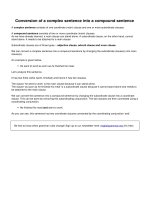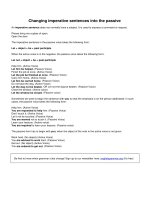Joining two or more simple sentences into one compound sentence
Bạn đang xem bản rút gọn của tài liệu. Xem và tải ngay bản đầy đủ của tài liệu tại đây (14.58 KB, 1 trang )
Joining two or more simple sentences into one compound
sentence
A compound sentence is one having two or more co-ordinate clauses. Hence it can be formed only with the help
of coordinating conjunctions.
By using and, as well as, both…and etc
Note that these conjunctions merely add one statement to another.
Alice wrote the letter. She posted it.
Alice wrote the letter and posted it.
Tom passed the test. James also passed the test.
Tom, as well as, James passed the test.
He has many admirers. He also has several detractors.
Not only has he many admirers, but also several detractors.
By using but, yet, whereas, nevertheless
These conjunctions are used when contrasting statements have to be joined together.
He is ill. He is cheerful.
He is ill but cheerful.
He is rich. He is miserable.
He is rich, yet miserable.
Tom is ambitious. His brother is quite the reverse.
Tom is ambitious whereas his brother is quite the reverse.
By using or, either…or, nor, neither…nor, otherwise etc
These conjunctions are used when two alternative facts or statements have to be presented.
You can go by bus. You can go by train.
You can go by bus or train.
He does not smoke. He does not drink.
He neither smokes nor drinks. OR Neither does he smoke nor does he drink.
You must work hard. You will not win.
You must work hard otherwise you will not win.
Stay on top of your writing! Download our grammar guide from www.englishgrammar.org to stay up-to-date.
Powered by TCPDF (www.tcpdf.org)









